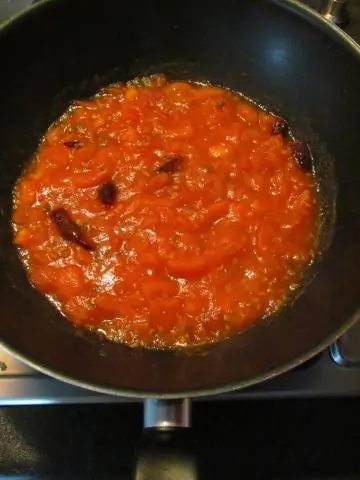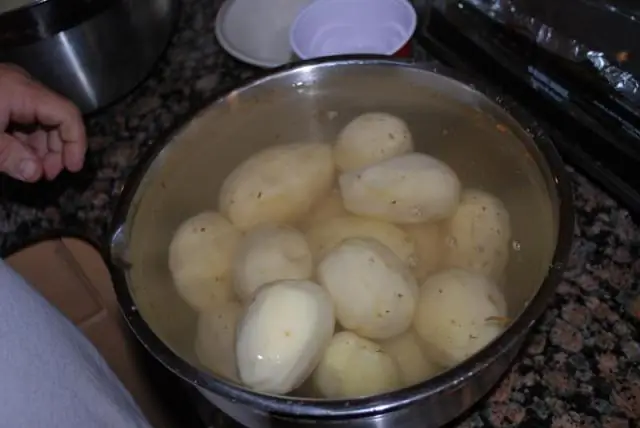
Table of contents:
- Author Bailey Albertson [email protected].
- Public 2023-12-17 12:53.
- Last modified 2025-01-23 12:41.
The armor is strong, but our hands are quick: how to peel a pumpkin

Thanks to the vitamins A, C, E, group B, PP, microelements (potassium, magnesium and others), fiber, pectin contained in pumpkin, it rightfully occupies a leading place in terms of usefulness in human nutrition. It is suitable for children, including infants, the elderly, and pregnant women. The unique composition of the pulp makes the vegetable useful for preventing the development of cardiovascular diseases, it has a diuretic, antiemetic effect, helps to fight toxicosis of pregnant women, insomnia. The vegetable helps with anemia and exhaustion of the body, liver disease and many other diseases. Its seeds are no less useful. Regardless of the part, pumpkin should be properly peeled before use.
Content
-
1 What kind of fruit is this vegetable
- 1.1 Large-fruited
- 1.2 Hardfaced
- 1.3 Nutmeg
- 2 To clean or not to clean
-
3 How to peel a pumpkin from a tough peel: options with a photo
3.1 Procedure for cleaning pumpkin
-
4 Little tricks
4.1 How to quickly and easily peel a pumpkin - video
What kind of fruit is this vegetable
Pumpkin has been known for over 5 thousand years. The place of origin is Central and South America, where the ancient Indians began to use it. The fruit was brought to Russia in the 16th century.

The usefulness of pumpkin for nutrition can hardly be overestimated.
There are many varieties of pumpkin. They differ in color and size, shape and purpose. There are ornamental varieties, the pulp of which is inedible, but the unusual shape and color of the fruit can decorate a garden plot or winter garden. Some varieties are grown for livestock feed or for seeds. Currently, three types are most often cultivated:
- large-fruited;
- firm-mouthed;
- nutmeg.
Large-fruited
The name of these varieties speaks for itself. The fruits are large in size and weight, they are also the sweetest. In some varieties, the sugar content reaches 15%, which is more than in the sweetest watermelon. The skin of such pumpkins is rather thin, while they are well stored in a city apartment.
The weight of this species can reach a centner; there is a known case of growing fruits weighing more than 500 kg. The fruits are usually round or oblong. There is a large cavity with seeds inside.
Large-fruited varieties include the varieties "Stolountovaya", "Titan", "Kupchikha", "Teschenka" and others. The varieties are resistant to low temperatures.

Some pumpkin specimens can reach several hundred kilograms.
Hard-faced
It is inferior in size to large-fruited and has a very hard peel, more like a nutshell. This species matures quickly. Already in late August - early September, you can eat them. Hard pumpkin seeds are the tastiest.
In addition to being eaten, they are also valuable as raw materials for making dishes. It is for which the housewives do not like to deal with them so much - the hard shell, has found application in this area. Dishes made from it are lightweight, durable and environmentally friendly.
The flesh of hard-bore pumpkins is looser and can be quite rough. Allocate the "Spaghetti" variety with fibrous pulp, in appearance really reminiscent of spaghetti. Another interesting variety is gymnosperms. Pumpkin seeds of this variety do not have an outer hard shell and are very tasty. This variety is not stored for a long time due to the fact that the seeds can sprout inside the pumpkin itself.

When stored for a long time, the skin of the pumpkin thickens and hardens
Muscat
This pumpkin is also called butternut - butternut. It has a bottle or pear shape. Almost all of them are bright orange flesh with a nutty flavor, dense and buttery. There are few seeds and they are located in a small cavity in the thickened part of the fruit. Butternut squash is considered the most delicious and vitamin-rich of all types.

The dense, buttery flesh of butternut squash has a nutty flavor
Its pulp is rather sweet, the sugar content can reach 11.5%.
This species belongs to mid-ripening and late-ripening, for ripening it needs a warm climate. But there is nothing wrong if the vegetable did not have time to ripen in the garden, it will successfully do this during storage.
Housewives' headache - how to peel a pumpkin. This process is especially problematic in winter, when the skin hardens even more from long storage. But we are not used to retreating.
To clean or not to clean
For housewives wondering whether it is necessary to peel a vegetable, there is good news: not necessary. It all depends on the dish that you are going to cook from it. And you can cook a variety of such dishes, from the well-known millet porridge, to the filling for pies, salads and meat dishes.

The peel of the baked pumpkin is easily peeled off after cooking
The pumpkin can be simply baked in the oven, sprinkled with sugar or watered with maple syrup, you can stew it in the oven on a baking sheet, adding a little water, you can rub it on a grater - in all these cases, you do not need to remove the skin at all. With baked and stewed, it can be easily removed after cooking, just throw away the rest of the grated crust. There are recipes when dishes are cooked in a whole pumpkin, here the question of cleaning is not worth it.

Cooking in a pumpkin eliminates the need to peel off hard skin
How to peel a pumpkin from a tough peel: options with a photo
But if the recipe still requires adding the vegetable in the form of slices, you have to roll up your sleeves. Everything is simple with a thin and soft skin, it can be easily removed with a knife or a triangular-shaped potato peeler. It's another matter if the skin is hard, like a shell.
Pumpkin cleaning procedure
- First of all, the vegetable must be washed well.
-
Then, with a wide long knife, cut off the lid and bottom. This will help give the fruit stability during further processing.

We clean the pumpkin First, cut off the lid and bottom
- Cut the pumpkin in half from the lid to the bottom.
-
Use a spoon to pick out the seeds along with the fibers. Set aside the seeds. Then they need to be freed from fibers and dried.

We clean the pumpkin Seeds and fibers are easy to scrub with a spoon
-
Place the pumpkin on a cutting board, cut down and using a planing motion from top to bottom, cut the skin off.

We clean the pumpkin With a sharp knife we cut the peel from top to bottom
- If the pumpkin is very large and the skin is very hard, the fruit can be cut into quarters or wedges. Focus on what size pieces are more convenient for you to work with.
-
The butternut squash is not cut lengthwise, but across. First, the upper part of the half is "planed", then the lower part is turned over and processed.

We clean the pumpkin Cut the butternut squash crosswise into two parts
Little tricks
- Before peeling the fruit, prick it in several places with a knife and send it to the microwave for 2 minutes. Set maximum power. During this time, the skin will soften and it will not be difficult to remove it. Cut a large pumpkin in half.
- If there is no microwave oven, the same can be done in the oven. You will need 10-20 minutes for this, depending on the size of the piece. Watch the process so that the pulp does not bake with the skin. After such a bath, the hardest peel is removed with an ordinary knife.
- The cut pumpkin remaining from cooking can be stored in the refrigerator, but not more than a week. Heat treated will deteriorate even faster. Better to cut the fruit into pieces, put in bags and place in the freezer. So it will last longer and at the same time will not lose its properties.
- It is very convenient to cook semi-finished products from a vegetable. Grind the baked pumpkin in puree and store in the freezer. Such puree can be delivered as needed and added to porridge, soup or other dishes.
- If you do not pre-treat the pumpkin with heat, use a saw-knife for cleaning, it will go faster with it.
How to quickly and easily peel a pumpkin - video
Despite the sugar content, this vegetable can be considered a dietary one, 100 grams of its pulp contains only 28 kcal, and a large amount of fiber gives a feeling of fullness for a long time.
The hard skin of a pumpkin is not a reason to refuse this, such a healthy and tasty vegetable. Choose for yourself a suitable way to get rid of pumpkin "armor" and please yourself and your home with a variety of vitamin dishes of this bright fruit.
Recommended:
How To Peel Peppers And Quickly Peel Off A Spicy, Bulgarian Or Other Variety

Why and how they peel and remove seeds from pepper. Are there any differences in the methods of cleaning fresh and baked vegetables. The nuances of peeling hot peppers
How To Quickly Peel Squids, Including Frozen Ones, And Quickly Get Rid Of The Film + Photos And Videos

Do you think peeling squid is a difficult and energy consuming task? We will dissuade you of this
How To Peel Pomegranates: Ways To Do It Quickly And Correctly, Photos And Videos

Step-by-step instructions for easy cleaning of a pomegranate. Detailed descriptions of different methods
How To Defrost Meat At Home Quickly And Correctly In A Microwave, Hot Water, Oven And Other Methods + Photos And Videos

How to defrost meat at home. Methods in the microwave and without it, in hot or cold water, in the refrigerator and others. Pros and cons of methods
How To Peel An Avocado For Different Purposes, How To Quickly Peel Off, How To Remove A Pit: Effective And Easy Ways To Peel A Fruit

Methods for peeling avocados. How to cut an avocado into cubes, slices. How to peel unripe fruit
